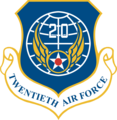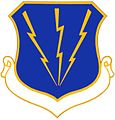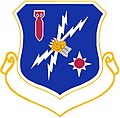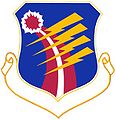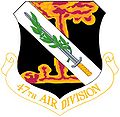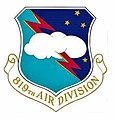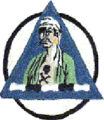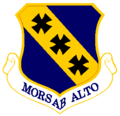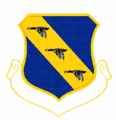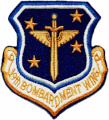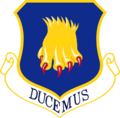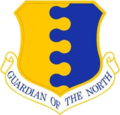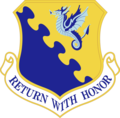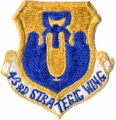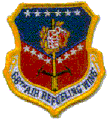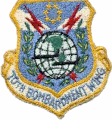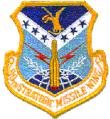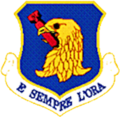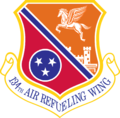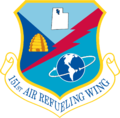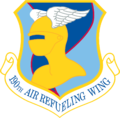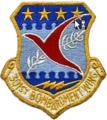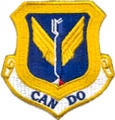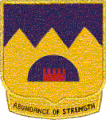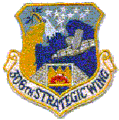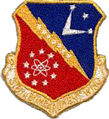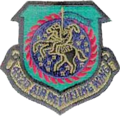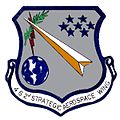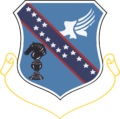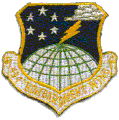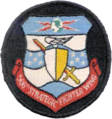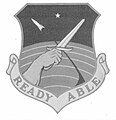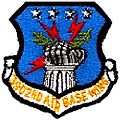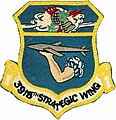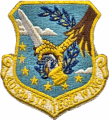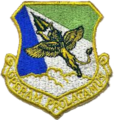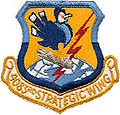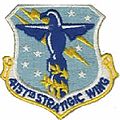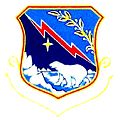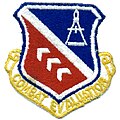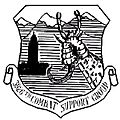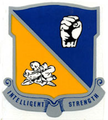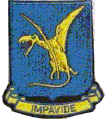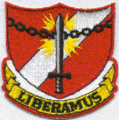Strategic Air Command Emblems
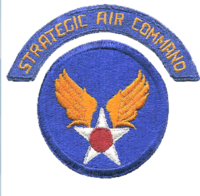


Strategic Air Command (1946-1992) was established as a Major Command of the United States Air Force in the aftermath of World War II on 21 March 1946.
With the end of fighting in the Korean War, President Eisenhower, who had taken office in January 1953, called for a "new look" at national defense. The result: a greater reliance on nuclear weapons and air power to deter war. His administration chose to invest in the Air Force, especially Strategic Air Command. During the Cold War, SAC became the most powerful air deterrent force to aggression ever created. Responsible for two "legs" of the defensive nuclear triad of the United States during the Cold War, over a million men and women served in SAC, its forces on alert 24 hours a day, every day, with a mission to preserve the peace and deter any aggressor nation from attacking the United States and its allies.
On 1 June 1992, when Strategic Air Command stood down, the Cold War which existed during much of its operational life was over, not by combat, but by consensus. SAC performed its mission not by using its tremendous force, but by its presence.
Wing Abbreviations[edit]
SAC had a myriad of wing types over its 46 year existence. These are the common abbreviations:
- ABW=Air Base Wing
- ANG=Air National Guard
- ATRW=Aerospace Reconnaissance Technical Wing
- ARW=Air Refueling Wing
- BG=Bombardment Group
- BW=Bomb Wing
- CCTW=Combat Crew Training Wing
- FIW=Fighter Interceptor Wing
- FW=Fighter Wing
- MW=Missile Wing
- RW=Reconnaissance Wing
- SAW=Strategic Aerospace Wing
- SFW=Strategic Fighter Wing
- SMW=Strategic Missile Wing
- SRW=Strategic Reconnaissance Wing
- SW=Strategic Wing
- SWW=Strategic Weapons Wing
- T&TW=Tactical and Training Wing
- TTW=Training and Testing Wing
- W=Wing
Unit emblems[edit]
Below are the emblems of most Strategic Air Command major units. Displayed in hierarchical precedence, then by numerical designation. Combat Groups are shown only for the 1946/1947 United States Army Air Forces units assigned to SAC.
Numbered Air Forces[edit]
Numbered Air Forces (NAF) were the major organizational unit of SAC in the organizational pyramid, reporting to HQ Strategic Air Command. Geographically-oriented, Eighth Air Force exercised command and control generally over SAC units east of the Mississippi River, and Fifteenth Air Force to the west. This changed in 1949 when Second Air Force was activated and controlled SAC units in the Southeast and the regional areas became less defined over the years. In addition to the Contiguous United States (CONUS), the NAF controlled various SAC overseas units. Eighth AF controlled units assigned to Newfoundland and Labrador in Canada, also units in Greenland and Europe; Fifteenth AF controlled units in Alaska and the Pacific; Second AF controlled units in Puetro Rico. Beginning in 1957, Sixteenth Air Force controlled SAC units deployed to North Africa and Europe at forward deployed REFLEX bases until its reassignment to USAFE in 1966. Twentieth Air Force was activated in 1991 to directly control ICBM Missile Wings.
-
Second Air Force 1949-1956 1991-1992
-
Second Air Force 1956-1991
-
Eighth Air Force 1946-1992
-
Fifteenth Air Force 1946-1992
-
Sixteenth Air Force 1957-1966
-
Twentieth Air Force 1991-1992
Divisions[edit]
Divisions were an intermediate command echelon of SAC, generally controlling groups of two or more combat wings and reported to their assigned NAF. Depending upon their mission, they could control groups of Aircraft (Air); ICBM Missile Wings (Missile) or a mixture (Strategic Aerospace). Divisions were also formed grouping wings of specific weapons systems (ex: B-47; B-52; Atlas ICBM), being activated or inactivated as these weapons systems were activated or retired over time, and redesignated as their component wings changed equipment or themselves were activated or inactivated.
-
1st Strategic Aerospace
1954-1956; 1957-1991 -
3d Air
1954-1970; 1975-1982 -
4th Air
1952-1988 -
5th Air
1951-1952; 1957-1958 -
6th Air
1951-1966; 1968-1969 -
7th Air
1951-1965; 1978-1992 -
12th Air
1951-1990 -
13th Missile
1959-1966 -
14th Air
1951-1991 -
17th Air
1959-1971 -
18th Strategic Aerospace
1959-1968 -
19th Air
1951-1988 -
21st Air
1951-1952; 1955-1964 -
22d Strategic Aerospace
1959-1965 -
36th Air
1951-1960 -
40th Air
1951-1957; 1959-1988; 1989-1991 -
42d Air
1951-1957; 1959-1969; 1970-1991 -
45th Air
1954-1989 -
47th Air
1951-1987 -
57th Air
1951-1957; 1951-1969; 1975-1991 -
100th Air
1990-1991 -
801st Air
1952-1966 -
802d Air
1952-1960 -
806th Air
1952-1960 -
810th Strategic Aerospace
1952-1971 -
813th Strategic Aerospace
1954-1956; 1959-1966 -
816th Strategic Aerospace
1958-1965 -
817th Air
1966-1971 -
818th Strategic Aerospace
1954-1965 -
819th Strategic Aerospace
1956-1966 -
820th Strategic Aerospace
1956-1965 -
821st Strategic Aerospace
1959-1971 -
822d Air
1959-1966 -
823d Air
1956-1971 -
825th Strategic Aerospace
1955-1970
Combat Wings[edit]
Combat Wings in SAC were the primary level of command which were designed to engage in combat operations. Wings were structured to fulfill a mission from a specific base, and contain a headquarters, combat squadrons and various support groups and squadrons. In SAC they primarily reported to the Division level, but could and did report to Numbered Air Forces, and in some cases, directly to Headquarters SAC. Wings were designated by a combination of a number and weapons system or other identifier, the abbreviations listed above.
SAC had two types of wings assigned.
- Air Force-controlled (AFCON) organizations with a continuing lineage and history. Numbered and contain from one to three digits in the numerical part of their designation.
- Temporary major command-controlled (MAJCON) organizations without a continuing lineage or history. Numbered and contain four digits in the numerical part of their designation. Many of the SAC MAJCON wings were inactivated and replaced by AFCON wings.
AFCON wings[edit]
-
1st FW
-
2nd BW and Wing
-
4th FW
-
5th SRW B-29 Era
-
5th BW B-36 Era
-
5th Bomb Wing
-
6th BW B-29 and B-36 Era
-
6th BW, 6th SAW, 6th SRW and Wing
-
6th SW
-
6th SRW
-
7th BW B-36 Era
-
7th BW
-
7th BW
-
9th BW B-29 Era, 9th SAW , 9th SRW SR-71,U-2 era
-
9th BW B-36, B-47 Eras and SW B-36 Era
-
11th BW B-36 Era
-
11th ARW, 11th BW and SAW
-
11th Strategic Group
-
12th SFW
-
17th BW and RW
-
17th BW B-52 Era
-
19th ARW
-
19th BW B-29 and B-47 eras
-
19th BW
-
22nd ARW and BW
-
26th SRW
-
27th FEG
-
27th FW and SFW
-
28th BW and SRW
-
31st FW and 31st SFW
-
33rd FW
-
39th BW
-
40th BW B-29 Era
-
40th BG and BW B-47 Era
-
42nd BW and 42nd Wing
-
42d BW
-
43rd BW
-
43rd SW
-
44th BW B-29 Era
-
44th BW
-
44th MW and SMW
-
55th SRW and Wing
-
55th SRW B-47 Era
-
56th FW
-
58th BG
-
68th ARW
-
68th BW B-29 Era
-
70th SRW
-
70th BW
-
72nd BW B-36 Era and SRW
-
72nd BW
-
82d FW
-
90th MW
-
90th SRW B-47 Era
-
90th SMW
-
91st BW
-
91st MW
-
91st SMW
-
92d ARW
-
92nd BW B-36 Era
-
92nd BW
-
92nd SAW
-
93rd BW B-29 Era
-
93rd BW B-47 Era
-
93rd BW
-
95th BW B-36 Era
-
96th BW B-47 Era
-
96th BW
-
96th BW B-1 Era
-
97th BW B-47 Era
-
97th BW
-
98th BW B-29 Era
-
98th SAW and SW
-
99th SRW B-36 Era
-
99th BW
-
99th SRW
-
99th SWW
-
99th T&TW
-
100th ARW, BW, SRW
-
101st ARW(ME ANG)
-
108th ARW (NJ ANG)
-
111th SRW (PA ANG)
-
126th ARW (IL ANG)
-
134th ARW (TN ANG)
-
141st ARW (WA ANG)
-
151st ARW (UT ANG)
-
157th ARW (NH ANG)
-
161st ARW (AZ ANG)
-
168th ARW (AK ANG)
-
171st ARW (PA ANG)
-
190th ARW (KS ANG)
-
301 BW B-47 era
-
301 ARW KC-135 Era
-
303d BW
-
305th ARW
-
305 ARW
-
305th BW B-58
-
306th BW B-29 Era
-
306th BW B-47 Era
-
306th BW
-
306th SW
-
307th SW
-
307th SW
-
308th BW B-29 Era
-
308th BW B-47 Era
-
308th SMW
-
310th BW, SAW, TTW
-
319th BW, Wing
-
320th BW B-29 Era
-
320th BW B-47 Era
-
321st BW B-47 Era
-
321st SMW
-
340th ARW, BW
-
341st SMW
-
351st MW
-
351st MW
-
351st SMW
-
376 BW B-29 Era
-
376th BW B-47 Era
-
376th SW
-
379th BW
-
380th ARW
-
380th BW B-47 Era
-
380th BW
-
381st SMW
-
384th ARW
-
384th BW B-47
-
384th BW B-1
-
389th SMW
-
390th SMW
-
397th BW
-
407th SFW
-
410th BW
-
416th BW
-
449th BW
-
450th BW
-
451st SMW
-
452d ARW (Subdued)
-
454th BW
-
455th SMW
-
456th BW
-
456th SAW
-
461st BW
-
462d SAW
-
465th BW
-
484th BW
-
494th BW
-
497th ARW
-
499th ARW
-
500th ARW
-
506th SFW
-
508th SFG
-
508th SFW
-
544th ARTW
-
702d SMW
-
702d SMW (Snark)
-
704th SMW
-
706th SMW
MAJCON wings[edit]
-
3902d Air Base
1948-1986 -
3918th Strategic
1964-1965 -
3920th Strategic
1964-1965 -
3960th Strategic
1965-1970 -
3970th Strategic
1964-1965 -
4038th Strategic
1958-1963 -
4039th Strategic
1958-1963 -
4043rd Strategic
1959 -
4045th Air Refueling
1959-1962 -
4047th Strategic
1961-1963 -
4061st Air Refueling
1959-1961 -
4080th SRW
1960-1966 -
4081st Strategic
1955-1966 -
4082nd Strategic
1957-1966 -
4083rd Strategic
1957-1959 -
4123rd Strategic
1957-1963 -
4126th Strategic
1959-1962 -
4128th Strategic
1959-1963 -
4130th Strategic
1958-1963 -
4133rd BW (P)
1958-1963 -
4133rd Strategic
1958-1963 -
4134th Strategic
1958-1963 -
4135th v
1958-1963 -
4136th Strategic
1958-1963 -
4137th Strategic
1959-1963 -
4138th Strategic
1959-1963 -
4141st Strategic
1958-1963 -
4157th Strategic
1964-1965 -
4158th Strategic
1964-1965 -
4170th Strategic
1959-1963 -
4200th SRW
1964-1966 -
4228th Strategic
1958-1963 -
4238th Strategic
1958-1963 -
4239th Strategic
1956-1963 -
4241st Strategic
1958-1963 -
4245th Strategic
1959-1963 -
4252nd Strategic
1965-1970 -
4258th Strategic
1966-1970 -
4258th Strategic
1966-1970 -
4321st Strategic
1959-1962 -
4347th Combat Crew Training
1958-1963 -
4397th Air Refueling Training
1958-1962 -
4397th Air Refueling Training
1958-1962
STRATEGIC AIR COMMAND SUPPORT GROUPS (1950's - 1992)[edit]
-
1st AEROSPACE COMMUNICATIONS GROUP
-
1st RADAR BOMB SCORING GROUP.jpg
-
1st COMBAT EVALUATION GROUP
-
3909th COMBAT SUPPORT GROUP
-
3910th COMBAT SUPPORT GROUP
-
3926th COMBAT SUPPORT GROUP
-
3974th COMBAT SUPPORT GROUP
-
4000th AEROSPACE APPLICATIONS GROUP
USAAF Combat Groups[edit]
SAC was established in March 1946, 18 months before the United States Air Force became a separate branch of the United States military. At that time, the Army Air Force Air Combat Group was the primary level of command which were designed to engage in combat operations. After the establishment of the USAF in September 1947, combat groups were assigned to a new level of command, the "Wing" as a subordinate unit. By 1952, most combat groups were inactivated, and the individual combat squadrons were assigned directly to the Wing Commander.
Most group emblems are presented, along with the date of assignment to SAC.
-
2d Bombardment
July 1947 -
7th Bombardment
October 1946 -
27th Fighter
June 1947 -
28th Bombardment
August 1946 -
40th Bombardment
March 1946* -
43d Bombardment
October 1946 -
44th Bombardment
March 1946* -
55th Fighter
February 1947 -
90th Bombardment
July 1947 -
91st Strategic Reconnaissance
July 1947 -
92d Bombardment
October 1946 -
97th Bombardment
August 1946 -
98th Bombardment
July 1947 -
301st Bombardment
August 1946 -
307th Bombardment
August 1946 -
444th Bombardment
March 1946* -
448th Bombardment
March 1946* -
449th Bombardment
March 1946* -
467th Bombardment
March 1946* -
485th Bombardment
March 1946* -
509th Composite
March 1946* -
509th Bombardment
August 1946
Note: * One of the initial ten bomb groups assigned to Strategic Air Command upon its activation.





